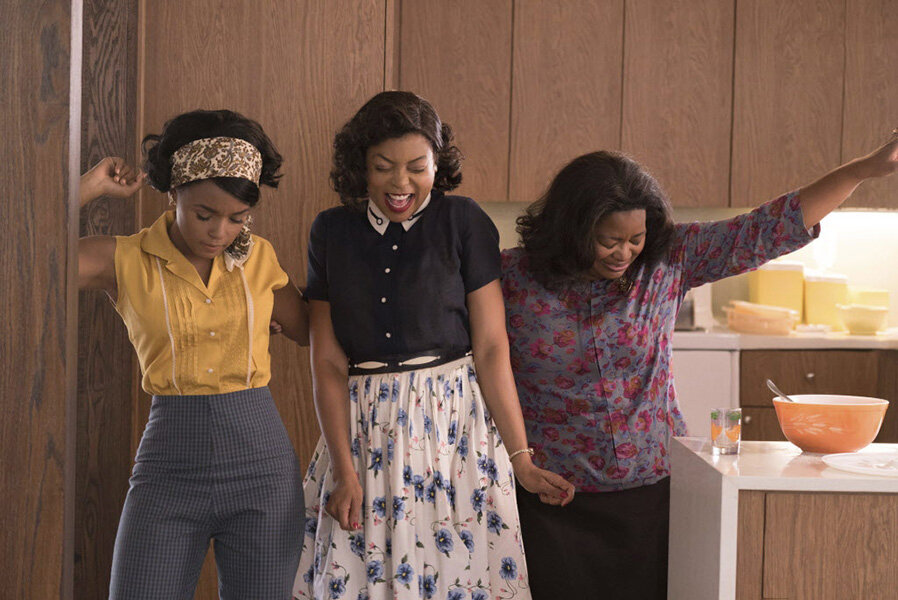Doing the math: Why 'Hidden Figures' adds up for moviegoers
Loading...
In 1962, astronaut John Glenn became the first American to orbit Earth – and now a film about the African-American women who helped him get there is reaching the box-office stratosphere.
The success of "Hidden Figures" hints at a nation yearning for inspiring, true stories and serves to undermine false stereotypes about race and gender, which persist in Hollywood – and the American workplace – today.
Critics lauded the movie, which stars Taraji P. Henson, Octavia Spencer, and Janelle Monáe, when it opened to limited release Dec. 25. It's since garnered Golden Globe nominations for the score and for Ms. Spencer’s performance, as well as nominations from the Screen Actors Guild for the best cast prize and Spencer for best supporting actress.
And now it's finding an audience with the average filmgoer. “Hidden Figures” was released widely on Jan. 6, where it emerged victorious against “Star Wars” behemoth “Rogue One” after a tight box office race, coming in at No. 1 for the weekend.
“What's really wonderful and refreshing about [the movie’s success] is that not only is there a very clear, easy-to-grasp positive message within the story, [but] that defying conventional wisdom once again, here is a movie that has opened to massive business featuring as protagonists not only people of color, but females," says Mark Evan Schwartz, associate professor of screenwriting at the School of Film & Television at Loyola Marymount University.
"The fact that it upstaged a major franchise tentpole as grandiose as a ‘Star Wars’ movie," he adds, "sends a very clear message to the kind of entertainment general audiences are looking for.”
Paul Levinson, professor of communication and media studies at Fordham University and editor of "Touching the Face of the Cosmos,” says that some of the movie's success may be due to the divisive US political climate.
“It has to be said that some of President-elect Trump's support has come from white supremacist groups, and at the same time we’re obviously near the very end of the tenure of the first African-American president,” Professor Levinson says.
“So I think it's really more important than ever in American culture to highlight the contribution that African-Americans have made to our culture and in particular women, who never get enough credit," he says. "This is part of the great American story.”
Professor Schwartz agreed. “Given today's political climate, I think that audiences are really hungering for positive messages,” he says. "I think it is such an important counterpoint to what's going on right now politically in this country. It's a ray of optimism in an environment right now that's becoming frighteningly pessimistic.”
Some industry watchers say the movie could top the box office again this upcoming three-day weekend, even against Mark Wahlberg in “Patriots Day,” the family movie “Monster Trucks,” and Ben Affleck’s “Live By Night,” among other competition.
Given the film's reach, "Hidden Figures" can help shift attitudes and inspire young women to pursue careers in mathematics and science. “[They] can look at these women as positive role models and think, whatever the obstacles are, I can rise up and I can do great things,” Schwartz says.
'The Right Stuff'
Realistic space travel films have been a proven draw with audiences in recent years. The 2015 hit “The Martian” took place in a near-future in which inhabitants of Earth had traveled to the Red Planet, while 2013’s “Gravity” centered on an imagined orbital mission gone wrong.
Past hits like 1995’s “Apollo 13” and 1983's "The Right Stuff" – also, of course, based on true stories – also brought in moviegoers.
Levinson sees "Hidden Figures" as demonstrating the continuing appeal of inspiring true stories. “You don't just need to make far-fetched adventure movies in order to succeed,” he says. “I mean, those are a lot of fun, but there is a lot of adventure in real-life successes.”
The movie is teaching Hollywood a lesson that it sometimes appears to keep learning: that filmgoers will turn up for stories with women at the center and those with racially diverse casts.
The 2011 movie “Bridesmaids,” with its female ensemble cast, stunned the industry when it became a smash box office hit, while observers have noted the stellar financial performance of the “Fast and the Furious” film series, which stars a diverse cast including Vin Diesel, Michelle Rodriguez, and Dwayne Johnson and will debut an eighth installment this April.
"Star Wars: The Force Awakens,” which became the highest-grossing film of all time without adjusting for inflation when it was released in 2015, starred actors of color including John Boyega and Oscar Isaac and centered on female protagonist Rey (Daisy Ridley).
Diversity wins
In the success of "Hidden Figures," Schwartz sees a clear lesson: “Give general movie-going audiences entertainment that they're looking for – and they're clearly looking for stories of diversity,” he says.
Meanwhile, “Hidden Figures,” which was put into production in 2015, is competing in an awards season that is under the shadow of two back-to-back years of the #OscarsSoWhite controversy, in which the Academy of Motion Picture Arts and Sciences nominated only white actors for the Oscars acting awards for two years in a row.
“I think that [the #OscarsSoWhite situation] probably has an impact on the people nominating in these categories, paying closer attention to stories about people of color because of the controversy from last year,” Schwartz says. “But I don't think it had anything to do with the actual making of the movie."
Now, Levinson says, “Hidden” could disrupt the troubling Oscars trend.
“Taraji P. Henson is obviously a fabulous actress, so – she lights up the screen whatever she does, whether it's television or movies,” he said. “And I would be stunned if she were not nominated and the movie didn't receive some Oscar nominations as well.”






